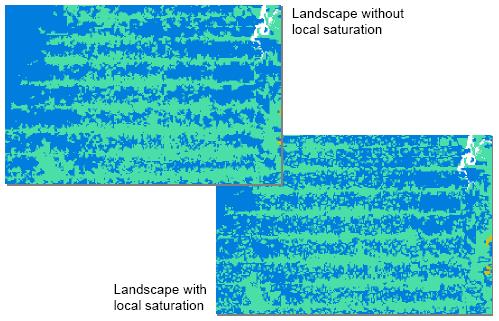Using local saturation
Load the model simulate_deforestation_using_local_saturation.egoml from \Guidebook_Dinamica_5\Models\additional_resources_lucc\local_saturation. Local saturation prevents a change from occurring within a specific region, in which a class area is greater than an established threshold (Fig.1). This feature is useful to simulate diffusion process as well as to establish a minimum forest remaining area (as established by the Brazilian forest code for private properties). Local saturation can be implemented by reducing the probability of a transition using an asymptotic function as follows:
P2 = P1 * (Li – Oc) / (Li + Oc), case Li >= Oc
P2 = 0, case Li < Oc
where P2 is the new probability, P1 is the original probability, Li is the maximum number of cells of a particular class that is allowed to occur within a certain map neighborhood and Oc is the number of cells of that class within that neighborhood. In this example, deforestation must stop in a local region (in this case a window size of 59.25 hectares or 9 cells - 3×3 window) when 50% of this region is deforested. For each model step, the amount of deforested cells is calculated in every 3×3 window of the landscape map. In this case, the threshold consists of five cells as follows:
P2 = P1 * (5 - Oc) / (5 + Oc), case Li >= Oc
P2 = 0, case 5 < Oc
Three Calculate Map functors are added to a deforestation simulation model in order to incorporate the saturation effect. Open them to see their equations. The first one assigns “1” to deforested cells and “0” to forest. The second counts the amount of cells deforested within a window size 3×3. It uses a neighborhood operator as follows:
nbCount(i1, 3, 3)
where nbCount is the neighborhood counting operator, i1 is map #1, and 3,3 is the window size in cells. You could easily increase the neighborhood size, changing these values. Then, a third Calculate Map is added to apply the local saturation rule on the probability map as follows:
if v1 - i1 >= 0 then i2 * (v1 - i1) / (v1 + i1) else 0
Where v1 is the saturation value in number of cells (in this case equal to 5).
As a result, deforestation will cease in local regions as they reach a saturation threshold and move to new areas with lower probability of deforestation, simulating therefore the diffusion of deforestation.

